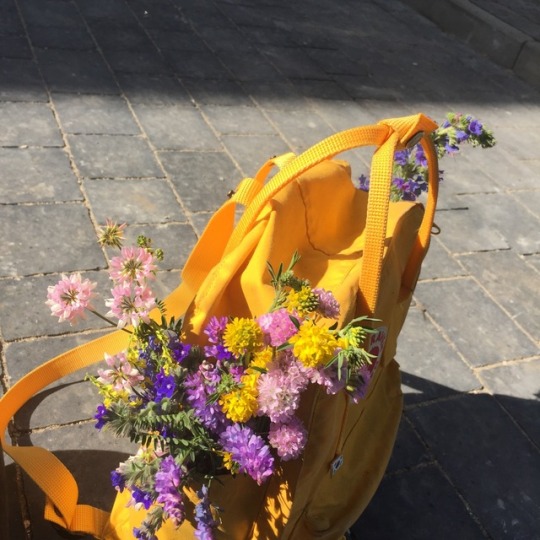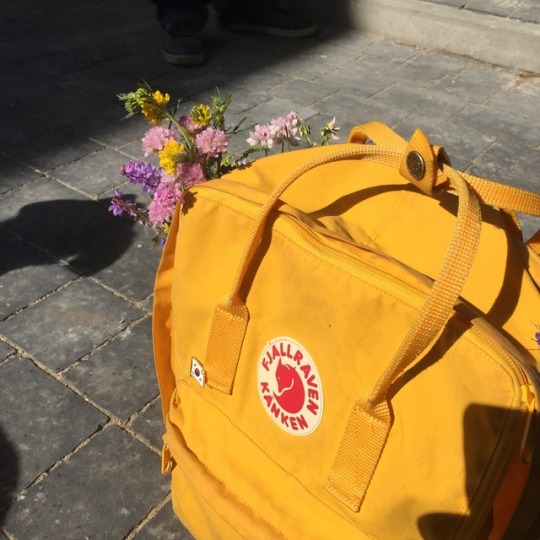A blog I use to let out bottled-up feelings / re-blogger
Don't wanna be here? Send us removal request.
Text
Helpful Tip for Cleaning Kanken Backpacks!!
Kankens are extremely sturdy backpacks (my grandma’s had one for 10+ years) but cleaning them can be a finicky process (For the love of all that is sacred to you, do NOT throw it in the washing machine). If you have a light colored kanken or just need to remove a mark/stain, use a magic eraser. Wet a corner of the magic eraser and scrub as needed. Wet an entire side for larger areas. It’ll remove dye stains from denim jeans, dirt, charcoal, etc. After scrubbing, run it under lukewarm water in the shower to get the grime off and then air dry. I do this every few months or as needed and my peach kanken is practically spotless (and I’m an art major). Best of luck!
527 notes
·
View notes
Photo


I thought I’ve found every kind of flower in my neighborhood, but I was wrong 😌
8K notes
·
View notes
Photo

the story so far // let it go.
Know you’re sad inside, so why you act so tough?
819 notes
·
View notes
Text
Tips for people who like to write by hand
So you’re an old timey writer who enjoys the feeling of paper as you breathe life into a story? Or, like me, you can’t use your phone at school and just wants to get some writing done while math class bores the others?
Well, me too and I’ve come to your aid! I’ve done some pretty stupid things that costed me hours and hours of searching for lost scenes and struggling to find ideas I knew I’d written down so you don’t have to!
Find the right notebook for you
By experience, notebooks take a long time to be filled. In good nanowrimo times, I take from 6 to 8 months to finish one. So you’ll be stuck with this guy for a long time. Make sure to pick one that you like and is right for your needs. I, for example, prefer spiral notebooks. You can rip out pages if you need to (if you mess it up, if someone asks you for one, if you just need a page to write down a grocery list or something, etc) and you can put a pen on the spiral. I also like having a pocket to put pieces of ideas I have.
Some spooky stories about having the wrong notebook:
I got stuck with a brochure old planner for two years. My mom didn’t use it in the year it was meant for, so I thought oh, it’s free real estate. As it turns out, it had really small space between the lines, so the pages would take forever to fill, it had all those day and hour numbers and the paper was really thin. It was terrible and it made writing terrible. It would have been a thousand times better if I just spent a few bucks on a regular notebook.
More recently, I started using just the kind of notebook I like, a spiral notebook with a pocket. But I bought it a couple of years ago at a fandom event I attended and the cover was a personalized Divergent cover. At the time, I thought if was pretty cool and everyone would know the reference. But now it has aged so very poorly. The cover has blood all over it and it says “Faction Before Blood”. So now I’m scared to pull it out to write at uni and people will think I’m in a gang or something.
Number your pages
I know, it sounds like a lot of work. But you can get a notebook with pages already numbered, number it yourself or do it like I do and number it every 10 pages (just because it’s easier). If you don’t feel like doing all of this repetitive work, date your writing. It’s cool to see how much you progressed, how long you have been writing this project, when you had this idea, etc. One thing doesn’t have to exclude the other, but both methods serve the same purpose.
And this purpose is to help you get an idea of how much you write (and feel good about your progress) and to help you organize yourself on all you’ve been writing. Which takes us to the next tip.
Make the first page an index
Not only it will take the pressure off the first page, it will also help you so you don’t keep losing the awesome stuff you’re writing and forgetting it exists. Everytime you start a new scene or change projects, go to the index and write down the page or the date you started this new section. Since I number every ten pages, I find the first page with a number on it and start counting forward or back to the new page. But you can do it in any way that suits you.
Make a random idea page
It doesn’t have to be the second page (it usually isn’t for me), but it’s good to have one. Sometimes, in the middle of writing, you have that great idea for something you need to change on what you’ve already got, or you got a completely new insight. It’s good to have your idea page somewhere close you can just flip to, write it down and get right back to writing. And don’t go easy on that page! Write it diagonally, vertically, draw on it, anything. It’s just there to take out those ideas so you can take a look at it another time and not mess the flow you’re in right now.
Keep your enemies close. And your pen even closer!
You know your favorite bic friend? It has a secret weapon just for you to use. That little flap of the cap? Use it to keep your pen always close. I normally put it on the spiral of my notebook. But if you have a brochure, you can put it on the cover. Sometimes it damages it a bit, but it’s a good trade for having it always ready for action. If you use moleskine, I saw that they normally have designated pen places. If they don’t, I have a tip for it just under this one!
Take your time to find which kind of pen is your weapon of choice. Personally, I think nothing beats a black ballpoint pen. I know some people like fineliners for writing, but they make the other side of the paper all gross looking and I like to keep it clean. Plus, I write really small and fineliners often bleed in my handwriting. I took my time searching for my favorite brand and I settled on Molin ballpoint pens.
I would recommend buying your favorite pens in bulk. Nothing is worse than pen hunting around when you have an urgent idea. I bought 50 pens for super cheap and I stack them EVERYWHERE. In all my bags, in my sketchbooks, in my bullet journal, in my writing notebook, in my drawers, anywhere I think it will be easy to find one when I need it ( also giving some to my friends who keep stealing my pens).
Crafting the perfect notebook
You don’t have to be a crafter to modify your notebook to better suit you! Find a ribbon anywhere in the house. Cut it to be a little longer than the book. Tape that bad boy to the inside of the back cover and everytime you stop writing, put that ribbon on the page you stopped. This helps you not to get lost in your previous writing and get right back to business when you resume.
Also, if you really like that moleskine vibe but don’t have the cash, just get a regular clothing elastic, make cut it just the size of the notebook and glue both ends to the inner part of the back cover. There you go! Now you can close it (and keep it closed).
If you like post-its, you can take half of the block (or however many sheets you cant put in there and still close the notebook comfortably) and glue it to the inside part of the cover of your notebook so it will always be conveniently available for you.
If your notebook doesn’t have a place to put your pen on and you really don’t want to mess up the cover, you take a small elastic (smaller than the pen) and tape (or preferably glue it) it to the back part of the notebook with both ends inside. There! Ready for the trip! Speaking of which…
Always carry your notebook with you
You never know when inspiration is going to strike. In class. At the bank. In a mall. Whenever you have a little time, you can write something. Or just take a look at what you’ve done and feel good about it.
Not in the mood for writing? Edit. Reread what you’ve done and start finding what you want to change once you type it in. When doing this, don’t be scared to cross out entire sentences and rewriting them on top. If it starts getting too messy, go to a blank page and rewrite the scene and you think it should have been done the first time. It seems counter-intuitive in a copy+paste kind of age, but I assure you it is worth it.
Typing your work
This is one of the biggest reasons I love writing in pen and paper. When you type, your first round of editing is done!
Don’t zone out when typing. As I said, typing is your first round of editing. It is important to keep aware of all of the things you might have done wrong when writing. Some people say writing it on paper and then typing it is a waste of time. I say it saves time and lives.
Keep it loose!
Just because you are writing in an actual physical book, it doesn’t mean you are writing a actual physical book. This is still your notebook and these are still your notes. So don’t be afraid to get messy. Write things out of order (seriously, it’s okay to not go chronological. i know it’s hard). Outline. Sketch. Tip-ex the whole thing. Get post-its on it. Take notes. Make genealogical trees. Draw maps.
If you’re feeling down or uninspired, try very basic writing exercises: write what you see, what you feel, something to try and make you laugh or something to make someone cry. It’s your place to express yourself. And once you got those creative juices flowing, happy writing :)
I hope you enjoyed my tips and please, feel free to reblog this with your own tips and tricks. I’d love to hear them! And follow me for some more writing content!
4K notes
·
View notes


























